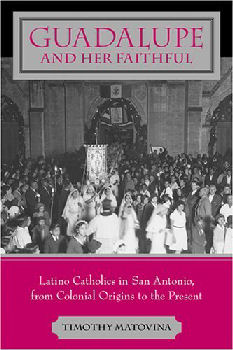
|
Posted March 8, 2006
Book: Guadalupe and her Faithful: Latino Catholics in San Antonio, from Colonial Origins to the Present Author: Timothy Matovina The John Hopkins University Press, Baltimore, MD, 2005, pp.232 An Excerpt from the Jacket:
Engaging recent scholarly analysis of ritual studies, lived religion, Latino theology and history, transnationalism, and ethnicity, Guadalupe and Her Faithful shows how religious traditions shape and are shaped by a faith community’s shifting contexts and power dynamics. This fascinating account reveals the potential force — and the potential limitations — of devotion in people’s lives and religious imagination. An Excerpt from the Book: Clearly mestizaje – the blending of traditions, cultures, and peoples – is an ambiguous and complex process. Guadalupan devotees at San Fernando [parish] exhibit a wide array of understandings about how Guadalupe accompanies and guides them as they forge their lives in the pluralistic society of the United States. For example, though some community leaders, like La Prensa’s writers, continued to promote the “traditional qualities of the Mexican woman,” which stemmed from the Guadalupan “Marian cult and her constancy at home,” after World War II ethnic Mexican women at San Antonio became increasingly involved in public activism for Mexican American rights, in political campaigns, and later in elective bodies like the city council. A growing number of women at San Fernando, particularly professional women, perceive Guadalupe as a model for and supporter of their expanding public roles and their work outside the home – an understanding of Guadalupe largely absent from the testimonies of male devotees. As parish leader Ester Rodriguez observes, “Guadalupe gives you dignity to go places you haven’t been before.” Table of Contents: 1. “Nuestra Madre Querida” 2. Patroness of la Frontera, 1731-1836 3. Defender of Dignidad, 1836-1900 4. Companion in el Exilio, 1900-1940 5. Celestial Mestiza, 1940-2003 Epilogue: The Future of Guadalupan Devotion |
|
